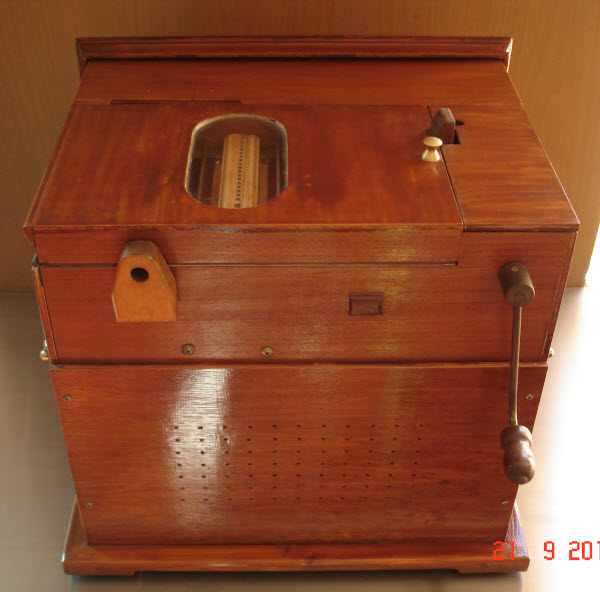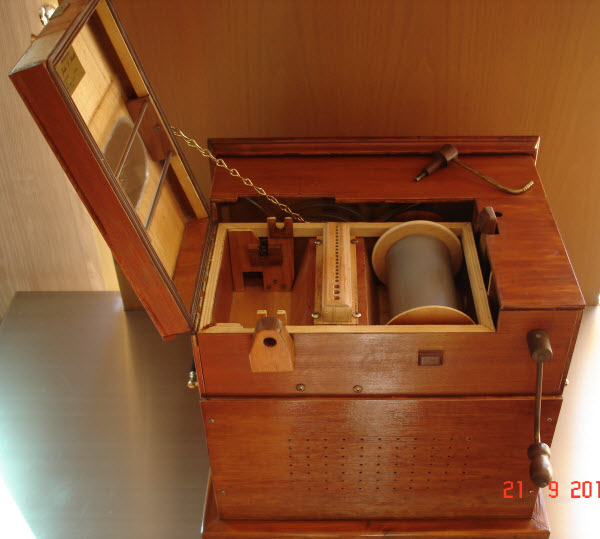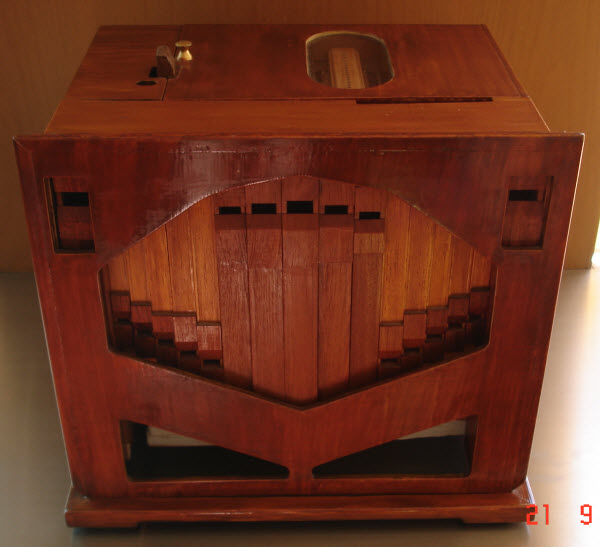Andrew Built This 20 Note Busker Organ – Designed By John Smith Of England – Over A 3-Month Period.
I received the photos below from, Andrew, a fellow model engineer living Thailand, with the following commentary:-
| This is a 20-note organ designed by John Smith, which I built over a 3-month period in Taiwan in 2006.
It was quite cheap to build as I got most of the wood from the scrap bin in B&Q (Taiwan). The expensive part was the lamb’s leather for the bellows, which I got from John Smith in England, UK. You also need an electronic tuner to tune each pipe otherwise the busker organ may sound a bit off! I still haven’t been able to find a suitable monkey (that comes complete with a little red hat), so my retirement plans to earn my upkeep by playing in Lumphini Park will have to wait a while!!! |
Here, are the photos of the busker Organ starting with a view from the side showing the winding handle.
The winding handle had two functions, it turned the perforated roll that controlled the floe of air to the organ pipes and it also operated the bellows to generated the necessary air pressure.
The next photo of the organ is an internal view showing the paper roll.
The next photo shows the front of the Busker Organ showing the organ pipes.
And here is a picture of Andrew with his John Smith’s Busker Organ complete with red-hatted monkey in Bangkok’s Lumphini Park in a vain attempt to top up his pension.
I hope you enjoyed those photos.
When I started to look into John Smith’s Busker Organ designs I because fascinated by the subject.
Here Are Some Of The Things I Have Learned About Busker Organs.
The John Smiths busker organ is a small portable organ with real wind-operated organ pipes that are blown by a bellows driven from a hand crank. The hand crank also feeds the paper roll which is perforated with holes and the air flows through these holes to the organ pipes to deliver the sound.
This clever design eliminated the complications of valves used on larger organs.
The 20 note busker organ as built by Andrew and shown in the photos on this page can be constructed quite easily by anyone with basic DIY or handicraft ability.
The plans to build the organ are available from the John Smith Busker Organ Website together with plans for making larger organs including a portable, 100 – pipe MIDI organ.
Other Pages In This Section




always wanted to make one myself but sadly cannot get the cash together for the plans
Very impressive work Andrew!!! I’m guessing that you make your own paper scrolls as well??
Mike,
Actually I bought the music rolls from Mervyn Wright off the internet. He makes the music and puts about 3 tunes onto each scroll. If the music is long you may only get one tune on it.
You can puck your tunes for each roll and hecwill prepare them for you and puts them in a nice box.
I have posted Alan a DVD of me playing the organ, but now relying on Thai Post to deliver it in one piece!
Regards,
Andrew
Hi Andrew
It looks superb I have always liked nice wood work and only wish I could work wood as well as you can. It is far more tactile than the cold steel and brass we normally work with So far none of the models I have made have wood bases as I have still to work out how to stain, seal and polish them. Any chance of a video with sound?
How is the coach coming along?
All the best George
Hello George,
I have a DVD of me playing it and the kids dancing to the music. They have now grown out of that phase!! It is too large a file to upload, but I could make a copy and post it to Alan if he likes.
The pipes are meant to be made from Balsa wood, but I faced some of mine with some hardwood. The three large bass pipes (hidden behind the back panel) are all balsa. There is not a lot of skill required in the woodwork front – lots of rectangular panels fitted together.
I stained the balsa wood parts but not the hardwood. The case is all cheap plywood off-cuts from B&Q and I used a stained on that, but not a very Goidelic one – a bit too shiny for me.
I am now working on the underframe for my coach. Just finished making the brackets for the battery boxes, the regulator, etc. I also finished the dynamo and support frame. I made the brake cylinders and have fixed the V-frames in place. So all going well, but I sometimes have to work at my office in order to get my salary!! I finished the buffers and draw hooks too but not yet fixed in place.
Andrew
Hi Andrew,
Lovely organ.
I just thought of one snag with your Lumphini Park retirement job – you aren’t allowed to work in Thailand. I don’t think that the “I’m not working, the monkey is” excuse would be accepted!
Best Regards
Alan Brown